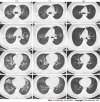Chlorine poisoning caused by improper mixing of household disinfectants during the COVID-19 pandemic: Case series
- PMID: 36157658
- PMCID: PMC9477020
- DOI: 10.12998/wjcc.v10.i25.8872
Chlorine poisoning caused by improper mixing of household disinfectants during the COVID-19 pandemic: Case series
Abstract
Background: Misuse of disinfectants during the coronavirus disease 2019 pandemic has led to several poisoning incidents. However, there are few clinical case reports on poisoning caused by improper mixing of household disinfectants.
Aim: To summarize the clinical characteristics and treatment effects of chlorine poisoning caused by improper mixing of hypochlorite bleach with acidic cleaning agents.
METHODSWe retrospectively analyzed baseline and clinical data, clinical symptoms, and treatment methods of seven patients with chlorine poisoning who were admitted to the National Army Poisoning Treatment Center.
Results: Among the seven patients, the average poisoning time (exposure to admission) was 57 h (4-240 h). All patients were involved in cleaning bathrooms. Chest computed tomography scans revealed bilateral lung effusions or inflammatory changes in five patients. The partial pressure of oxygen decreased in six patients, and respiratory failure occurred in one. Five patients had different degrees of increase in white blood cell count. Humidified oxygen therapy, non-invasive mechanical ventilation, anti-inflammatory corticosteroids, antioxidants, and antibiotics were administered for treatment. The average length of hospital stay was 7 d (4-9 d). All seven patients recovered and were discharged.
Conclusion: Improper mixing of household disinfectants may cause damage to the respiratory system due to chlorine poisoning. Corticosteroids may improve lung exudation in severe cases, and symptomatic supportive treatment should be performed early.
Keywords: Acidic cleaning agents; Chlorine poisoning; Household disinfectant; Hypochlorite bleach; Toxic lung injury.
©The Author(s) 2022. Published by Baishideng Publishing Group Inc. All rights reserved.
Conflict of interest statement
Conflict-of-interest statement: All authors declare that they have no competing interests.
Figures
References
-
- Quirce S, Barranco P. Cleaning agents and asthma. J Investig Allergol Clin Immunol . 2010;20:542–550. - PubMed
-
- McKenzie LB, Ahir N, Stolz U, Nelson NG. Household cleaning product-related injuries treated in US emergency departments in 1990-2006. Pediatrics. 2010;126:509–516. - PubMed
-
- Sabato V, Ebo DG. Comment on: Koppelman SJ, Jayasena S, Luykx D, Schepens E, Apostolovic D, de Jong GA, et al. Allergenicity attributes of different peanut market types. Food and chemical toxicology: An international journal published for the British Industrial Biological Research Association 2016. Food Chem Toxicol. 2016;92:256. - PubMed
-
- Yasseen Iii A, Weiss D, Remer S, Dobbin N, MacNeill M, Bogeljic B, et al Increases in exposure calls related to selected cleaners and disinfectants at the onset of the COVID-19 pandemic: data from Canadian poison centres. Health promotion and chronic disease prevention in Canada: research, policy and practice, 2021; 41: 25-29. - PMC - PubMed
LinkOut - more resources
Full Text Sources


